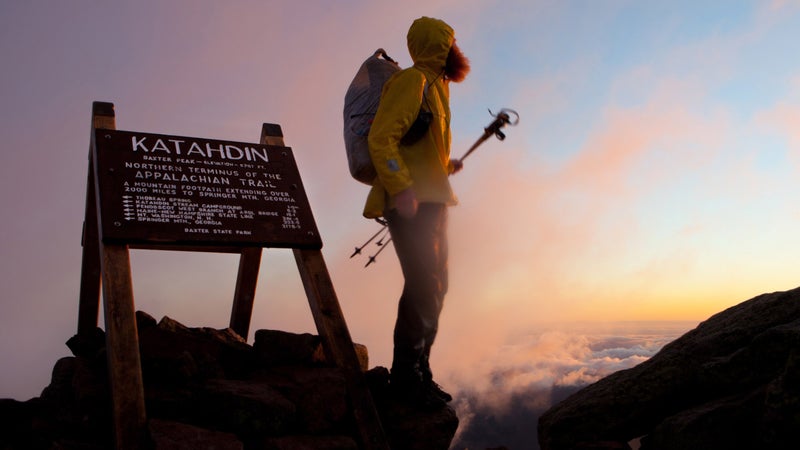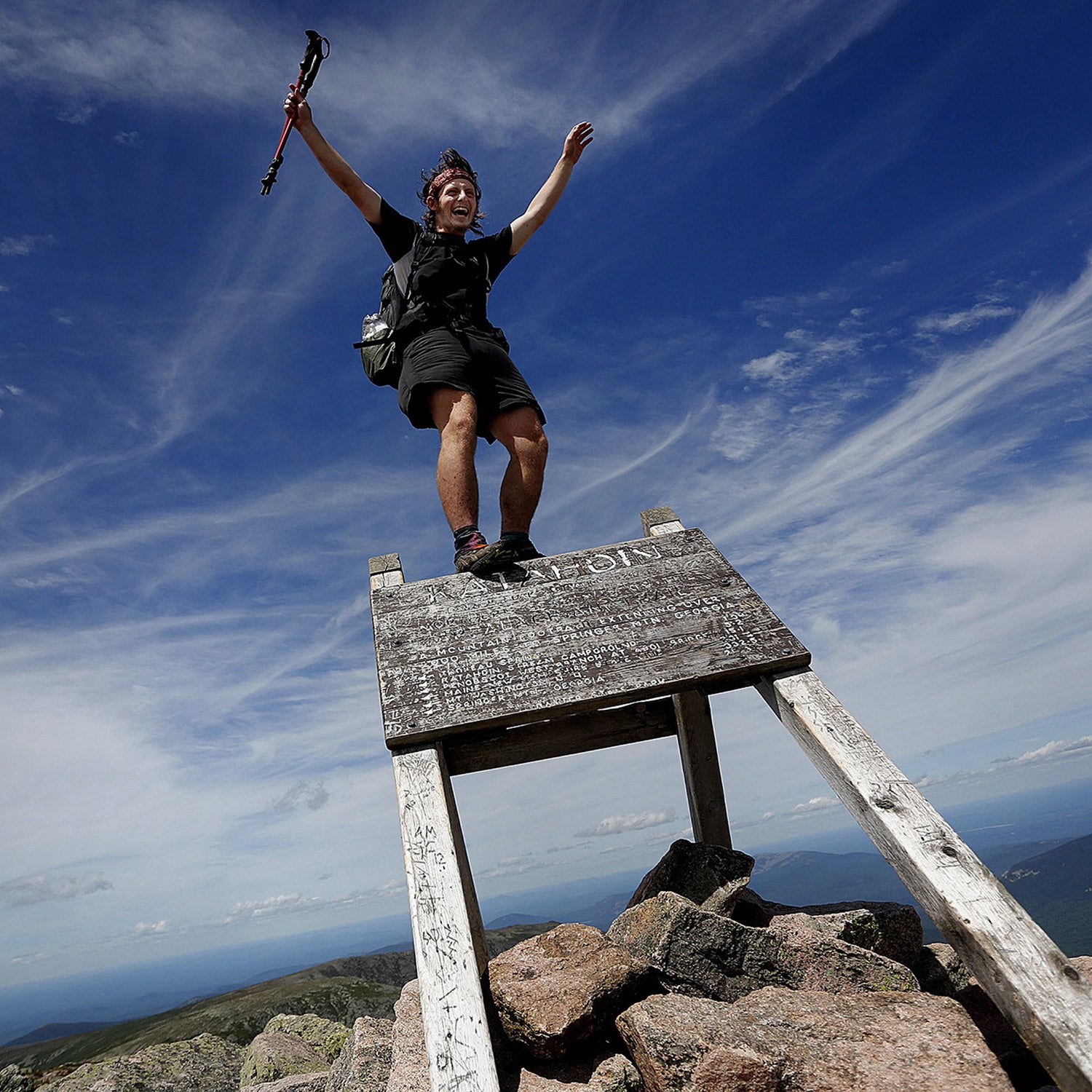Three years ago, Jensen Bissell, the director of Baxter State Park, the northern terminus of the Appalachian Trail, raised concerns to the Appalachian Trail Conservancy about the number of AT thru-hikers in the park. There were too many of them, he said, and many were flouting the rules—carrying open alcohol containers, camping illegally, forging service dog papers, you name it—and the sheer volume of foot traffic was wearing down the mountain's ecology and the trail's integrity. Since then, as traffic has continued to rise, the problems have only gotten worse. The trail, Bissell contends, wasn’t meant to handle the loads of hikers it sees today.
“The AT model is based on unlimited growth,” Bissell says. The trail conservancy and the National Park Service encourage people to use the trail but don’t effectively manage them, he says. “The trail's usage has already increased several hundred percent [in the past 25 years]. We don’t see any mechanism in the management model to prevent it from increasing another 2,000 percent.”
Though Bissell’s main concern is the impact of thru-hikers on Baxter, his attitude is shared by various managers up and down the 2,168-mile trail who see not only more total hikers but more disrespectful hikers and more damage to the trail. See, the trail wasn’t born of a single comprehensive design. It was strung together by linking dozens of smaller trails, some of which date back to the nineteenth century and were built by innkeepers looking to schlep Victorian guests up straight ridgelines. It passes through 14 states, eight National Forests, 21 wilderness areas, two additional National Park Service units, two parcels of land managed by the U.S. Fish and Wildlife, and several state parks, all of which have their own policies and enforcement protocols.
“What was once a solitary experience is now a place where I can go and get stoned every four hours if I want to,” says author Ben Montgomery. “I wouldn’t be surprised if you saw people starting to sell glow-in-the-dark hula-hoops and shit on the AT.”
No one could have predicted in 1921, when the trail was first conceived, how popular it would become today or what kind of abuse it would endure. Only three hikers completed the trail in the 1940s, according to the trail conservancy. The numbers were manageable in the 1970s when, during the course of the entire decade, a total of 775 thru-hikers completed the trail (for an average of about 77 hikers per year). Compare that to 2014, when more than 2,800 thru-hikers started the trail and an estimated three-to-four million people hiked a section of it.
In some respects, the popularity is a success—the trail conservancy and NPS want more hikers on the trail. But what rankles managers is the resultant uptick in trash, destruction, and misuse of the trail that is undermining the wilderness experience they seek to cultivate. “We definitely have a proliferation problem,” says Ron Tipton, executive director of the trail conservancy. It raises a thorny question for everyone involved in the nation’s most popular scenic trail: How many hikers is too many?
We’re about to find out.
Last year’s film Wild—Hollywood’s adaptation of Cheryl Strayed’s eponymous book about her journey on the Pacific Crest Trail—prompted a spike of thru-hikers on the AT. If that’s any indicator, imagine what will happen after September 2 with the film release of Bill Bryson’s 1998 novel A Walk in the Woods, about two aging men who take on the AT. The novel itself brought a 60 percent spike in traffic on the trail the following season, according to the trail conservancy.
At today’s rate, such a quick increase could put damaging strain on the trail, says Morgan Sommerville, Southern Regional Director of the trail conservancy. “If we get a 60 percent increase next year, it’s not going to be good for anyone.”
The trail isn’t the bastion of serenity it may have been 40 years ago, when it served as a venue for eco-minded individuals to commune with nature in isolation. Today, in addition to more thru-hikers on the trail, there are hundreds of naive and underprepared hikers, managers say, and they lug in more conventional possessions and leave more trash. Aside from finding beer bottles and tin cans on the trail, volunteers in Georgia reported removing blow dryers and mattresses during a cleanup effort earlier this year.
“It’s turned into a walking festival out there,” says Ben Montgomery, who studied the trail extensively for his New York Times bestseller, Grandma Gatewood’s Walk, a narrative of the first woman to complete an unassisted AT thru-hike. “What was once a solitary experience is now a place where I can go and get stoned every four hours if I want to. I wouldn’t be surprised if you saw people starting to sell glow-in-the-dark hula-hoops and shit on the AT.”
It’s not just a question of aesthetics. The ecology of the trail is suffering. Shenandoah and the Great Smoky Mountains National Park, for example, have both been scarred by stealth campers. Sections of the Mid-Atlantic and the White Mountains are showing signs of erosion, including the northern terminus at Mount Katahdin in Maine. Decades of boot traffic on the mountain’s peak, which was once a rich alpine meadow, have worn it bare, says Lester Kenway, president of the Maine Appalachian Trail Club. The Katahdin Butterfly, once prolific on the mountain, is now listed as endangered, a development managers associate with the boost in thru-hiker traffic.
Almost everybody interviewed for this article said they’ve noticed a shift in the past decade. Hikers are more self-entitled and disrespectful of the environment, they say.
Perhaps the hardest hit of all is the area surrounding Springer Mountain, the southern terminus of the trail where most thru-hikers begin their bids each spring. Pick a day in March or April, and it’s not uncommon to find 70 people trying to camp in an area designed for 25. This past year, more than 150 thru-hikers began their bids there on a single day.
The damaging effect of crowds isn’t lost on NPS. Last year, the service commissioned Jeff Marion, a research biologist for the U.S. Geological Survey, to undertake a three-year assessment of the trail and provide baseline data on the ecological and structural conditions of the trail. Marion, a longtime backpacker and leader in the field of recreation ecology, is concerned about what he’s seen so far. “There’s litter at shelters, people leaving used toilet paper right on the trail, hikers throwing used batteries into the fire,” Marion says. “I try to talk to them and they say they don’t care.”

Almost everybody interviewed for this article said they’ve noticed a shift in the past decade. Hikers are more self-entitled and disrespectful of the environment, they say. “I would love to know what percentage of the thru-hikers that ideology represents,” Marion says. “Based on the kinds of problems we’re seeing and the wide spread reports, we think it must be in the 20 percent range at least.”
This kind of abuse brings up the notion of trail “impairment,” a term first introduced by NPS’s Organic Act of 1916 and later strengthened by the Wilderness Act of 1964. The sum total of this legislation mandates that NPS manage its scenic trails in such a way that they are preserved in an unimpaired state, which is defined as the absence of any impact that could harm the integrity of the trails’ resources and values.
Wendy Janssen, the park service’s Appalachian Trail superintendent, wouldn’t go into detail about what kind of impairment the service has acknowledged on the trail in recent years. She faces the tough task of promoting the outdoors to new users—this year NPS has launched a campaign to engage city dwellers and people of color—while mitigating the impact of those users. “It’s a double-edged sword,” Janssen says. “We want to continue to reach out to new audiences. Folks in our national parks should reflect diversity in America and, quite frankly, we’re not there yet. We know we have to be very proactive about Leave No Trace tenets along the way. We don’t want to send the wrong message about how the Appalachian Trail is used.”
Late last month, representatives from the trail conservancy, the Long Distance Hikers Association, and Baxter State Park descended on a folksy lodge near the base of Katahdin for an all-day meeting to discuss how they might alleviate some of the problems on the trail. The meeting was a long-time coming and all the more pressing after ultrarunner Scott Jurek’s controversial speed-record champagne celebration on Katahdin in July. They came away with a tacit agreement to bump up education and outreach, but that was about it. The groups plan to meet again in October.
In terms of addressing the larger issue of how many people are on the trail, Janssen says establishing a carrying capacity for thru-hikers is a measure on the table. No other national scenic trails limit the number of people who can use them, in part because there are so many access points to these trail that such a measure would be impossible to enforce. After last season, NPS implemented a voluntary registration service online for thru-hikers so that everyone can see how many people plan to start hiking on any given day. But Janssen says the service is stopping short of issuing the kind of mandatory permit system used by the Pacific Crest Trail (a means of tracking hikers, not capping their numbers)—at least for now. The parks service and the trail conservancy are tabling any decisions until they see the results of Marion’s report, due out in 2017.
Meanwhile, state clubs—especially in places like Georgia and Maine—are working frantically to prepare for A Walk in the Woods. They’re redesigning campsites at some of the most overused shelters, installing new privies, and educating hikers about Leave No Trace Practices. At Baxter, Bissell, for his part, has floated the idea to NPS of relocating “key trail portions or the trail terminus” atop Katahdin as recently as November. Whether that's a realistic option is unclear. (Bissell told the New York Times this month that it was unlikely to happen.)
Will those measures counter the wear and tear from thousands of hikers pounding along the trail each year? Probably not, says Karl Meltzer, a Red Bull-sponsored ultrarunner who assisted Jurek on his trail run and who is planning a speed record attempt of his own next year. “If people keep having babies, the population will grow,” he says. “What does that mean? More people on the trail, bottom line. It's just reality, and you can't change reality.”

